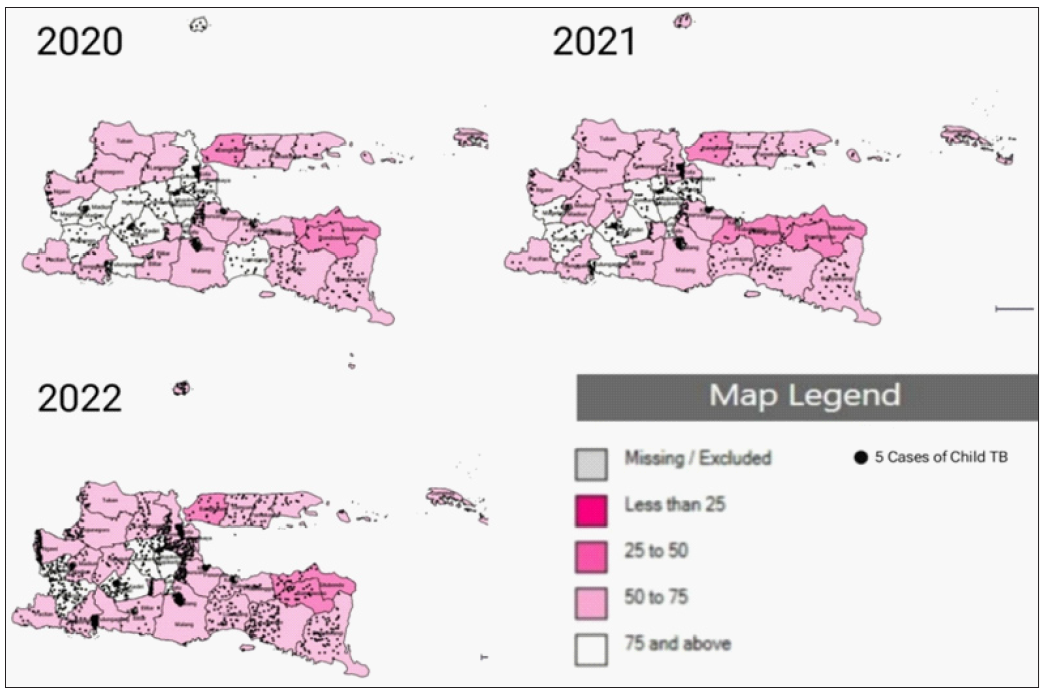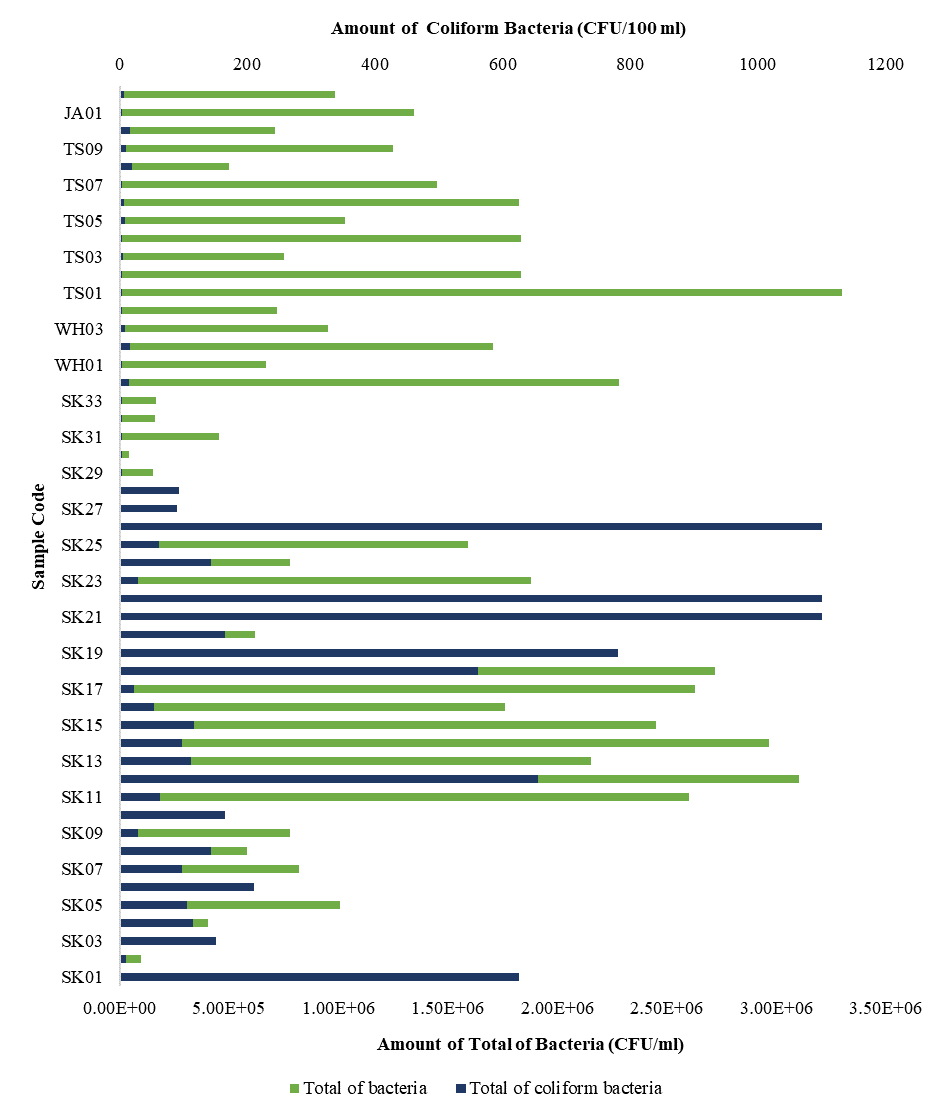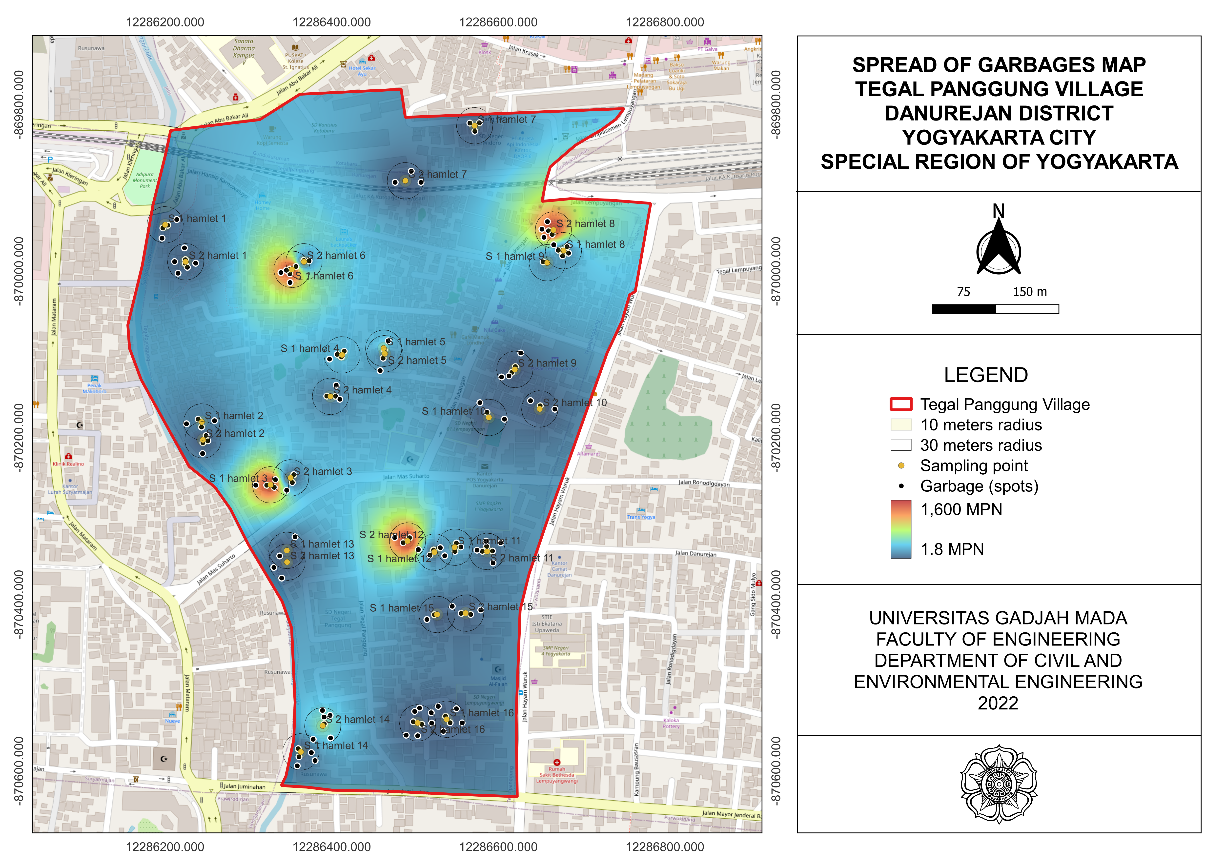Correlation Between Livable Housing, BCG Immunization Coverage, and Population Density with Child Tuberculosis Incidence in East Java Province 2020-2022

Introduction: Mycobacterium tuberculosis bacteria can cause tuberculosis disease. In 2022, East Java Province reported 8,398 cases of child tuberculosis with a discovery coverage of 105.6%. This study aims to describe the distribution of child tuberculosis incidence in East Java Province by mapping and analyzing the correlation between livable houses, BCG immunization coverage, and population density with the incidence of child tuberculosis in 38 districts/cities in East Java Province from 2020 to 2022. Methods: This was a descriptive approach with a population correlation study design using the Spearman correlation statistical test. Secondary records from the East Java Health Profile 2020, 2021, and 2022 were used in this study. Thirty-eight districts/cities in the province of East Java comprised the study's population. Results and Discussion: This study showed that there has been a positive correlation between BCG immunization coverage in 2020 (r=0.043); 2021 (r=0.140); 2022 (r=0.214) and population density 2020 (r=0.082); 2021 (r=0.102); and 2022 (r=0.174) with the incidence of child tuberculosis. Meanwhile, the correlation between livable houses and the incidence of child tuberculosis is negative in 2020 (r=-0.990) and 2022 (r=-0.047) but positive in 2021 (r=0.078). Conclusion: The increase in BCG immunization coverage and population density aligns with the increase in child tuberculosis cases. Meanwhile, an increase in the percentage of access to livable houses is followed by a decrease in the incidence of child tuberculosis.
Khan MK, Islam MN, Ferdous J, Alam MM. An Overview on Epidemiology of Tuberculosis. Mymensingh Med Journal. 2019;28(1):259–266. https://pubmed.ncbi.nlm.nih.gov/30755580/
Husada S, Anti T, Sari P. Potential Anti-Tuberculosis Activity of Gotu Kola Leaf Extract (Centella Asiatica L. Urban) in Inhibiting the Growth of Mycobacterium Tuberculosa. Jurnal Ilmiah Kesehatan Sandi Husada. 2020;9(2):878–888. https://doi.org/10.35816/jiskh.v12i2.429
Wijayanti HN, Tamtomo D, Suryani N. Hubungan Antara Pemberian Imunisasi BCG, Status Gizi dan Lingkungan Rumah dengan Kejadian Penyakit TB Paru pada Anak Balita. Holistik Jurnal Kesehatan. 2020;14(3):420–428. https://doi.org/10.33024/hjk.v14i3.2954
Prasetyo A. Tatalaksana Terkini Infeksi Laten Tuberkulosis pada Anak. Cermin Dunia Kedokteran. 2019;46(2):146–148. https://doi.org/10.55175/cdk.v46i2.515
Sterling TR, Njie G, Zenner D, Cohn DL, Reves R, Ahmed A, et al. Guidelines for The Treatment of Latent Tuberculosis Infection: Recommendations from The National Tuberculosis Controllers Association and CDC, 2020. MMWR Recomm Reports. 2020;6(1):1–11 https://doi.org/10.15585/mmwr.rr6901a1
Soesanto A, Anam MS, Arkhaesi N, Pratiwi R. Kejadian dan Faktor Risiko Tuberkulosis pada Anak Penghuni Padat Penduduk: Studi pada Rusun Kudu. Sari Pediatri. 2022;24(1):1-6 https://doi.org/10.14238/sp24.1.2022.1-6
Astuti SSK, Rakhmawati W, Hendrawati S, Maryam NNA. Pengetahuan dan Sikap Orang Tua Terkait Tuberkulosis Anak di RSUD Bhakti Dharma Husada Kota Surabaya. Jurnal Ilmu Pendidikan. 2020;5(6):1753-1768. https://doi.org/10.33024/mnj.v5i6.8784
Ministry of Health of the Republic of Indonesia. Indonesia Health Profile 2021. Jakarta: Indonesian Ministry of Health; 2022. https://www.kemkes.go.id/id/profil-kesehatan-indonesia-2021
Muharam T, Sudirman AA, Modjo D. Faktor Risiko Kejadian Tuberkulosis Pada Anak di RSUD Toto Kabila. Detector: Jurnal Inovasi Riset Ilmu Kesehatan. 2023;1(2):110–123. https://ejurnal.politeknikpratama.ac.id/index.php/Detector/article/view/1366
Nafsi AY, Rahayu SR. Analisis Spasial Tuberkulosis Paru Ditinjau dari Faktor Demografi dan Tingkat Kesejahteraan Keluarga di Wilayah Pesisir. HIGEIA (Journal of Public Health Research and Development). 2020;4(Special 3):460–469. https://journal.unnes.ac.id/sju/index.php/higeia/article/view/34567
Distric Health Office of East Java. Health Profile of East Java Province 2022. Surabaya: Distric Health Office of East Java; 2023. https://dinkes.jatimprov.go.id/userfile/dokumen/PROFIL KESEHATAN JATIM 2022.pdf
Hargono A, Syahrul F, Indriani D, Chalidyanto D, Megatsari H, Artanti KD, et al. Parent’s Knowledge about Immunization with Missed Opportunity for Vaccination in Children. Malaysian Journal of Medicine and Health Sciences. 2022;18(1):101–106. https://medic.upm.edu.my/upload/dokumen/2022110210162915_1481.pdf
Kusnanto K, Arifin H, Kurniawati Y. Determinant of BCG Vaccine Coverage among Indonesian Children Aged 0–2 Months. Children and Youth Services Review. 2020;116(1):1-6. https://doi.org/10.1016/j.childyouth.2020.105238
Wulandari DN, Salamah M. Pemodelan Jumlah Penderita Tuberkulosis di Provinsi Jawa Timur Tahun 2018 Menggunakan Metode Generalized Poisson Regression. Jurnal Sains dan Seni ITS. 2022;11(1):D36-D42. https://doi.org/10.12962/j23373520.v11i1.62721
Ministry of Health of the Republic of Indonesia. Tuberculosis Control Program Report 2021 Jakarta: Ministry of Health of the Republic of Indonesia; 2022.
Srisantyorini T, Nabilla P, Herdiansyah D, Dihartawan, Fajrini F, Suherman. Analisis Spasial Kejadian Tuberkulosis di Wilayah DKI Jakarta Tahun 2017-2019. Jurnal Kedokteran dan Kesehatan. 2022;18(2):m131–m138. https://jurnal.umj.ac.id/index.php/JKK/article/view/7343
Kristini T, Hamidah R. Potensi Penularan Tuberculosis Paru pada Anggota Keluarga Penderita. Jurnal Kesehatan Masyarakat Indonesia. 2020;15(1):24-28. https://doi.org/10.26714/jkmi.15.1.2020.24-28
Haq A, Achmadi UF, Susanna D. Analisis Spasial (Topografi) Tuberkulosis Paru di Kota Pariaman, Bukittinggi, dan Dumai Tahun 2010-2016. Jurnal Ekologi Kesehatan. 2020;18(3): 149–158. https://doi.org/10.22435/jek.v3i18.80
Ministry of Health Republic of Indonesia. Regulation of Ministry of Health Republic Indonesia No. 67 Year 2016 about Tuberculosis Prevention. Jakarta: Ministry of Health Republic of Indonesia; 2016.
East Java Central Bureau of Statistics. Housing and Settlement Statistics of East Java Province 2022. Surabaya: East Java Central Bureau of Statistics; 2023. https://jatim.bps.go.id/
Noerhalimah T. The Scope Of PHBS In Household And Healthy Home With The Incidence Of Tuberculosis In West Java. Journal of Public Health Research and Community Health Development. 2020;4(1):28-42. https://doi.org/10.20473/jphrecode.v4i1.15005
The United Nations International Children’s Emergency Fund. Desk Review: Pediatric Tuberculosis with A Focus on Indonesia. Jakarta: The United Nations International Children’s Emergency Fund; 2022. https://www.unicef.org/indonesia/reports/desk-review-pediatric-tuberculosis-focus-indonesia
Arifin S, Marlinae L, Husaini, Khairiyatie L, Waskito A. Penerapan Program Bina Rumah Sehat Untuk Percepatan Status Kesehatan Anak TB. Pro Sejahtera. 2020;2(1):43–51. https://snllb.ulm.ac.id/prosiding/index.php/snllb-abdimas/article/view/410
Alves YM, Berra TZ, Alves LS, De Assis IS, Arcoverde MAM, Ramos ACV, et al. Risk Areas for Tuberculosis among Children and Their Inequalities in A City from Southeast Brazil. BMC Pediatrics. 2020;20(1):1–9. https://doi.org/10.1186/s12887-020-02364-7
Siddalingaiah N, Chawla K, Nagaraja SB, Hazra D. Risk Factors for The Development of Tuberculosis among The Pediatric Population: A Systematic Review and Meta-Analysis. European Journal of Pediatrics. 2023;182(7):3007–3019. https://doi.org/10.1007/s00431-023-04988-0
Pratiwi RD, Pramono D, Junaedi J. Socio-Economic and Environmental Risk Factors of Tuberculosis in Wonosobo, Central Java, Indonesia. J Kesehat Masy. 2020;16(1):61–70. https://doi.org/10.15294/kemas.v16i1.12636
Savitri GAMA. Determinan Kejadian Tuberculosis Anak di Wilayah Kerja Puskesmas Sukorambi Kabupaten Jember. Skripsi. Jember: Universitas Jember; 2023. https://repository.unej.ac.id/xmlui/handle/123456789/118077
Ardiyanti M, Sulistyawati, Puratmaja Y. Spatial Analysis of Tuberculosis, Population and Housing Density in Yogyakarta. Epidemiology and Society Health Review. 2021;3(1):28–35. https://doi.org/10.26555/eshr.v3i1.3629
Mayasari E, Risnasari D, Chei NE. Analysis of Pulmonary Tuberculosis based on Home Sanitation in Sembung Hamlet, Margopatut East Java. STRADA Jurnal Ilmiah Kesehatan. 2022;11(1):78–83. https://doi.org/10.30994/sjik.v11i1.894
Ekawati D. Pengaruh Faktor Risiko, Usia, Jenis Kelamin dan Status Imunisasi pada Kasus TB Paru Anak di Puskesmas Merdeka. KOLONI Jurnal Multidisiplin Ilmu. 2022;1(3):965-971. https://koloni.or.id/index.php/koloni/article/view/395
Rita E, Qibtiyah SM. The Relationship of Contacts with Tuberculosis Patients to the Incidence of Pulmonary Tuberculosis in Children. Indonesian Journal of Nursing Sciences and Practice. 2020;3(1):35–41. https://jurnal.umj.ac.id/index.php/ijnsp/article/view/6900/4308
Martinez L, Cords O, Horsburgh CR, Andrews JR, Acuna VC, Desai Ahuja S, et al. The Risk of Tuberculosis in Children After Close Exposure: A Systematic Review and Individual-Participant Meta-Analysis. Lancet. 2020;395(10228):973–984. https://doi.org/10.1016/S0140-6736(20)30166-5
Roy RB, Whittaker E, Seddon JA, Kampmann B. Children and Mycobacterium Tuberculosis: A Review of Susceptibility and Protection. Lancet Infectious Diseases. 2019;19(3):e96–e108. https://doi.org/10.1016/S1473-3099(18)30157-9
Liao Q, Zheng Y, Wang Y, Ye L, Liu X, Jiao W, et al. Effectiveness of Bacillus Calmette-Guérin Vaccination Against Severe Childhood Tuberculosis in China: A Case-Based, Multicenter Retrospective Study. International Journal Infectious Disease. 2022;121(1):113–119. https://doi.org/10.1016/j.ijid.2022.04.023
Farsida, Febrianti R, Lutfy N, Rahmini, Syahniar R. Relationship between Nutritional Status and Living Conditions with the Risk of Tuberculosis in Children. Jurnal Kesehatan Masyarakat. 2023;18(3):341-348 https://doi.org/10.15294/kemas.v18i3.35343
Gutiérrez-González LH, Juárez E, Carranza C, Carreto-Binaghi LE, Alejandre A, Cabello-Gutiérrrez C, et al. Immunological Aspects of Diagnosis and Management of Childhood Tuberculosis. Infect Drug Resist. 2021;2021(14):929–946. https://doi.org/10.2147%2FIDR.S295798
Suryaningtyas NH, Inzana N. Gambaran Kejadian TB Anak Berdasarkan Cakupan Imunisasi BCG dan Lingkungan Rumah Di Provinsi Jawa Tengah Tahun 2017 dan 2018. Sel Jurnal Penelitian Kesehatan. 2020;7(1):19–32. http://ejournal2.bkpk.kemkes.go.id/index.php/sel/article/view/3453
Wulanda AF, Delilah S. Efektivitas Imunisasi BCG terhadap Kejadian Tuberkulosis Anak di Kabupaten Bangka. Jurnal Kesehatan Poltekkes Kemenkes RI Pangkalpinang. 2021;9(1):37–41. https://doi.org/10.32922/jkp.v9i1.333
Fatahillah H, Andarini I, Hidayah D. Hubungan Imunisasi BCG dengan Tuberkulosis Paru pada Anak Balita di RSUD Dr.Moewardi. Plexus Medical Journal. 2022;1(1):18–23. https://doi.org/10.20961/plexus.v1i1.15
Tanner R, Villarreal-Ramos B, Vordermeier HM, McShane H. The Humoral Immune Response to BCG Vaccination. Frontiers in Immunology. 2019;10(1):1–18. https://doi.org/10.3389/fimmu.2019.01317
Irham AR, Putri RM. Kepadatan Penduduk Terhadap Indeks Pembangunan Manusia di Provinsi Lampung. Media Komun Geogr. 2023;24(1):91–100. https://doi.org/10.23887/mkg.v24i1.60261
Tuntun M, Aminah S, Yusrizal CH. Distribution Pattern and Spatial Analysis of Factors for Tuberculosis (TB) Cases in Bandar Lampung City in 2022. Bali Medical Journal. 2023;12(1):50–58. https://doi.org/10.15562/bmj.v12i1.3918
Rao M, Johnson A. Impact of Population Density and Elevation on Tuberculosis Spread and Transmission in Maharashtra, India. Journal of Emerging Investigators. 2021;4(1):1–5. https://doi.org/10.59720/21-056
Lestari AA, Makful MR, Okfriani C. Analisis Spasial Kepadatan Penduduk Terhadap Kasus Tuberkulosis di Provinsi Jawa Barat 2019-2021. Jurnal Cahaya Mandalika. 2021;3(2):577–584. https://ojs.cahayamandalika.com/index.php/JCM/article/view/1663
Sugion S, Ningsih F, Ovany R. Hubungan Tingkat Pengetahuan Keluarga dengan Upaya Pencegahan Penularan Tuberculosis Paru di Wilayah Kerja UPT Puskesmas Pahandut. Jurnal Surya Medika. 2022;8(3):228–234. https://doi.org/10.33084/jsm.v8i3.4516
Farsida F, Kencana RM. Gambaran Karakteristik Anak dengan Tuberkulosis di Puskesmas Pamulang Tangerang Selatan. Muhammadiyah Journal of Midwifery. 2020;1(1):12-18. https://doi.org/10.24853/myjm.1.1.12-18
Ernirita E, Mujiastuti R, Awaliah A, Zuryati M, Widiastuti E, Idriani I, et al. Pemberdayaan Kemandirian Warga Sekolah Sehat dan Peduli TBC dalam Gerakan Bersama (Geber) Melawan Tuberkulosis. Kontribusi: Jurnal Penelitian dan Pengabdian Kepada Masyarakat. 2023;3(2):160–172. https://doi.org/10.53624/kontribusi.v3i2.207

This work is licensed under a Creative Commons Attribution-NonCommercial-ShareAlike 4.0 International License.
1. Copyright of all journal manuscripts is held by the Jurnal Kesehatan Lingkungan.2. Formal legal provisions to access digital articles of electronic journal are subject to the provision of the Creative Commons Attribution-ShareAlike license (CC BY-NC-SA), which means that Jurnal Kesehatan Lingkungan is rightful to keep, transfer media/format, manage in the form of databases, maintain, and publish articles.
3. Published manuscripts both printed and electronic are open access for educational, research, and library purposes. Additionally, the editorial board is not responsible for any violations of copyright law.
JKESLING by UNAIR is licensed under a Creative Commons Attribution-ShareAlike 4.0 International License.







































